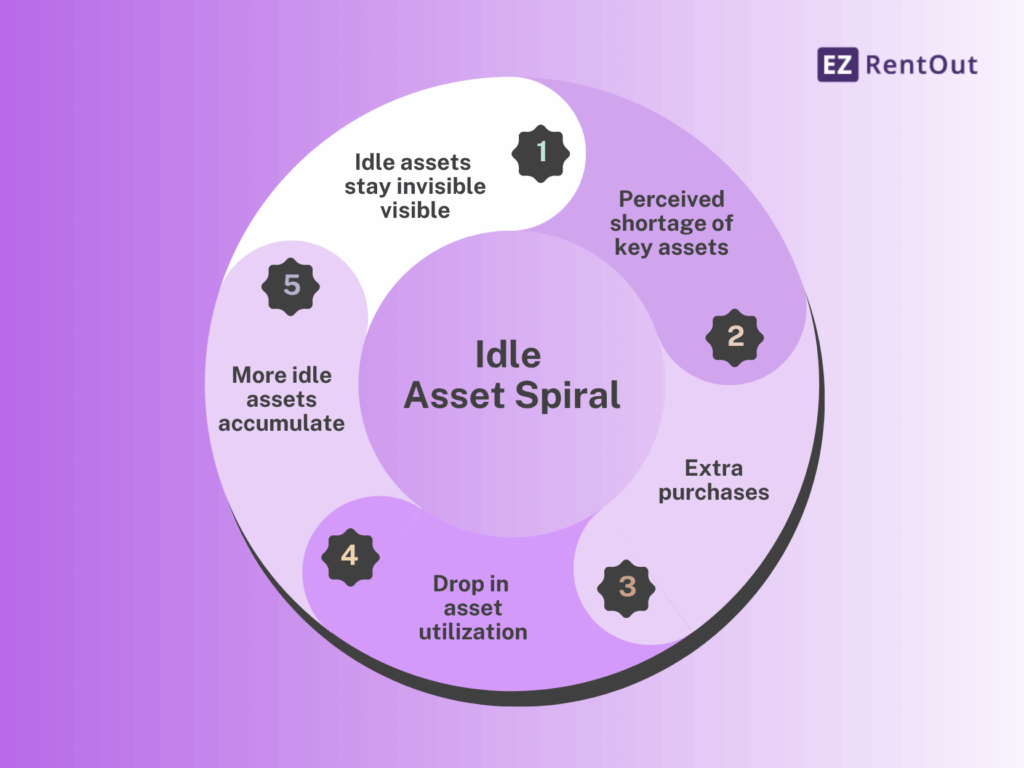The primary focus of every rental business, like yours, is generating revenue, which ultimately translates into profits.
Imagine having closed back-to-back construction rental deals, delivering your heavy equipment on time, and ensuring everything is billed and accounted for. Your rental fleet has increased, and you regularly rent equipment for new job sites; yet, your revenue does not look that promising. You look deeper into your spreadsheets and discover unexplained anomalies slowly eating away at your profits. What could those be?
You finally find the culprit: rows of excavators, forklifts, and earthmovers have been sitting idle for a long time, while only a few pieces have been rented out frequently. The result: depreciating equipment, accumulating maintenance, and zero returns on investment. Unused equipment often goes unnoticed if not strategically tagged and tracked over time.
But how can you identify idle equipment in construction and the costs associated with it? Let’s help you do that!
What qualifies as idle equipment?
In the construction rental industry, asset utilization is a key performance indicator (KPI) that determines the frequency of leads and revenue. Any piece of equipment that is not meeting its full utilization capacity and falls below a specific utilization threshold, such as 50% as per industry standards, is considered idle.
For instance, if an excavator is available for rent for 30 days but is only rented out for 5, its utilization rate is ~17%. That’s considered idle.
The criteria to identify a piece of equipment as idle vary depending on seasonality, demand, change in customer preferences, and equipment type. Some ways you can determine idle equipment based on its utilization include:
- Low time-based utilization: Any equipment not being frequently rented out during the time it’s available for rent will gradually qualify as idle. This is solely based on the availability time vs the number of times it’s rented out phenomenon.
- Low revenue-based utilization: You can calculate the revenue generated by a piece of equipment and determine whether it justifies the investment.
- Zero rental days: Set the number of days as per your organization to determine the threshold after which a piece of equipment will be considered idle. It could be 30, 60, or 90 days, depending on your set criteria.
- Uneven fleet usage: When specific units of an equipment type are rented out more frequently compared to others, it creates an uneven utilization pattern. With this in mind, if they remain unused due to a lack of visibility or poor scheduling, they are considered functionally idle.
Any piece of equipment that is not generating revenue due to a lack of visibility, internal mismanagement, data silos, poor tracking, or scheduling issues will eventually impact your sales and customer relationships. Idle equipment is not always malfunctioning or broken—it can simply be underutilized items.
Ways idle equipment hinders operational efficiency
Idle equipment often goes unnoticed if your construction rental business is not utilizing a rental asset management system to track both used and unused equipment. While it may seem like a minor inconvenience, it can create unimaginable ripple effects that slow down your daily business and construction workflows.
Whether you have noticed it or not, here’s how your business can be negatively impacted due to idle equipment:
1. Slow project turnaround time
Construction rentals are responsible for providing reliable and well-functioning equipment that does not break down during a job. However, if it does, the turnaround time to provide a replacement must be as low as a couple of hours. Not knowing the exact location of your equipment or needing to rely on outdated equipment logs to assess its whereabouts can significantly slow down your turnaround time.
The equipment might be sitting in your yard, but you are just not able to track it, leading to job site delays. These delays frustrate clients and hamper your long-term relationship with them.
| Example | Reason: Inability to track idle equipment due to reliance on outdated systemsOverall impact: Delayed projects and turnaround time | |
| A construction company needed a skid steer for a last-minute job. One was technically available but hadn’t been checked in properly after a previous rental. | Impact on Asset Utilization | Impact on Efficiency |
| Industry Benchmark: Time-based utilization should be ≥ 65% Observed: Equipment sits idle for 70% of the available time Idle Duration: 2 daysCrew idle cost: $2,500/day → $5,000 lostUtilization Impact: The asset shows 30% utilization this month instead of 70% | Project start delayed by 2 daysLabor costs: $2,500/day (crew idle) = $5,000Client dissatisfaction and potential loss of repeat business | |
2. Double bookings and scheduling conflicts
Sometimes, staff may book equipment without thoroughly checking the records and assume that the equipment is available, while it may not be. This usually happens when equipment is sitting idle and off the radar while the current equipment is being rented out repeatedly. This way, the available equipment may be booked twice while the unused equipment remains untracked and idle.
Double bookings is one of the major construction challenges that remains unresolvable if you are unable to identify unused equipment that can be rented out instead.
| Example | Reason: Inability to allocate idle equipment properlyOverall impact: Double bookings and frustrated customers due to delayed jobs | |
| Two job sites were promised the same backhoe loader because it was marked “available” in the system despite being held off-site. | Impact on Asset Utilization | Impact on Efficiency |
| Industry Benchmark: Rental software should maintain > 95% booking accuracy External rental cost: $600/dayEmergency delivery: $300Total Unplanned Cost: $900+Utilization dropped from 80% expected to 50% actual, due to one missed week of rental | One site had to rent a machine externally at $600/dayEmergency delivery cost: $300Total unplanned expense: $900+ | |
3. Disrupted maintenance planning
Unnoticed equipment often goes unmaintained. Maintenance managers often fail to schedule regular inspections and routine upkeep for such assets. As a result, these items remain unused and unserviced for long periods, leading to obsolescence or gradual deterioration. When the equipment is finally needed, the risk of breakdowns increases significantly.
Not maintaining the equipment properly from time to time impacts its use in the long run and impacts the ROI, especially when the equipment is expensive. As a construction rental business, ensuring regular maintenance ensures that you have satisfied customers.
| Example | Reason: Inability to maintain equipment on timeOverall impact: Unexpected equipment breakdowns on the jobsite | |
| A generator sat idle in storage for months and was overlooked during preventive checks. When urgently needed, it failed during startup. | Impact on Asset Utilization | Impact on Efficiency |
| Preventive Maintenance Benchmark: Idle assets must still follow a 30- or 60-day PM scheduleEmergency repair: $500Replacement rental: $300/dayDowntime loss: $800+Missed PM alert due to no recent check-in or usage = 0% utilization for 3 months | Job delay: 1 dayEmergency maintenance: $500Replacement rental: $300/dayTotal: $800+ in avoidable costs | |
4. Unnecessary equipment purchases
Poor visibility into the asset landscape creates confusion regarding the availability of equipment. You may end up requesting new equipment despite there being ample units available.
This problem is usually common for construction companies that have a large rental fleet, distributed across several job sites. The procurement team might fail to assess the correct number of units available without a centralized repository and place orders for more. Tens of thousands of dollars end up being tied up in unnecessary purchases—money that could be invested in high-performing assets. Eventually, managers discover the underutilized idle assets that have depreciated over time.
| Example | Reason: A lack of holistic data records, reflecting the number of all assets. Overall impact: Extra purchases that add to operational costs | |
| Due to poor visibility into idle inventory, the business bought a new mini excavator for $45,000, despite already owning two underused ones. | Impact on Asset Utilization | Impact on Efficiency |
| Benchmark: No new purchases unless utilization exceeds 80% for at least 3 consecutive monthsAverage utilization of existing excavators: 35%Capital waste: $45,000 tied upLost opportunity to invest in marketing, staff, or revenue-generating assets | Capital tied up for 6–12 monthsDepreciation without immediate returnsOpportunity cost of investing elsewhere (marketing, staff, better-performing assets) | |
5. Asset hoarding on jobsites
When construction managers bring several resources to the jobsite without fully assessing their needs, they contribute to the problem of asset hoarding. Equipment that is not required but is present at a construction site depreciates more quickly and experiences extensive wear and tear, thereby adding to the cost and occupying unnecessary space. Imagine having five excavators on a digging site when you needed only two.
Although these assets contribute to the safety buffer, their underutilization does not justify the investment.
| Example | Reason: Not assessing the number of pieces of equipment making up the existing fleetOverall impact: Overpurchasing and asset hoarding that waste resources | |
| Contractors kept a scissor lift on-site “just in case,” even though it hadn’t been used in over a week. | Impact on Asset Utilization | Impact on Efficiency |
| Target Utilization: ≥ 70% for high-demand assets like liftsMissed rental revenue: $120/day × 10 = $1,200Actual utilization: 20% over 30 days instead of the standard 70% | The lift remained idle for 10+ daysMissed rental opportunity: $120/day = $1,200Reduced availability for other projects | |

How to overcome inefficiencies caused by idle equipment?
According to a report, construction megaproject inefficiencies, with idle time being a key driver, can delay projects by 30% or more and result in cost overruns by 77%. Such inefficiencies often arise when equipment is not regularly monitored or logged into a system for recording. Addressing them helps construction rental businesses reduce the time and resources lost in managing idle equipment. Here’s how:
1. Invest in a rental asset management solution
Investing in construction equipment rental software will help streamline everyday rental workflows and enable you to track and monitor equipment from the moment it is procured. Such a system will allow you to consolidate rental data into a single platform, providing a real-time view of your assets’ locations, condition, and usage.
With complete visibility into your rental data, you will gain full control over your rentals, efficiently manage quantities, and identify any blind spots. You can also generate reports, track asset utilization KPIs, monitor idle durations by location or project, and conduct audits to identify unused equipment. This will help you determine which assets can be reallocated without disrupting the existing rentals.
Impact: No more ghost assets or delayed project starts due to “missing” equipment.
2. Tag your equipment
You can use GPS tracking to monitor the movement of each piece of equipment and ensure it stays in sight at all times. GPS tracking helps you follow every movement of your equipment in real-time, showing you its current location and destination if it’s in motion. You can even track if it’s under maintenance, in transit, or just idling. GPS tagging helps construction businesses:
- Avoid equipment theft or loss due to poor visibility
- Use them for redeployment or improved allocation
- Maintain the right amount of equipment to prevent overpurchasing
Similarly, categorize and tag assets so they can be tracked seamlessly without having to search through extensive records. You can track the exact location, status, and movement of your assets using QR codes and barcodes. Consistently monitoring equipment to prevent it from going unrecorded for months or being kept standing at a depot. If the on-site manager sees an unidentified excavator on a jobsite, they can quickly scan the code to see which location it belongs to.
You can easily assign unique identifiers to the equipment using your rental asset management solution and scan them using QR codes or barcodes for real-time tracking. Similarly, you can link your GPS systems via APIs or leverage in-built GPS tracking capabilities in a rental solution to track assets.
Impact: Real-time tracking enhances fleet accountability, reduces downtime between jobs, and helps improve utilization by 15–20% by identifying idle or misplaced equipment more quickly.
3. Automate maintenance and compliance
The best way to keep your equipment well-maintained and ensure it is used to its maximum potential is through regular maintenance. This can be achieved through automated service and maintenance features in your rental asset management solution, which will automatically put equipment into the service state once it is returned. Maintenance logs are created, and a comprehensive service history is maintained to ensure the equipment is ready for subsequent use. Any issues with the equipment can be flagged beforehand.
Not only this, but you can enable alerts that will remind you of an upcoming maintenance. These alerts will ensure that no equipment is overlooked, as you will stay on top of maintenance for all equipment. For instance, a backup generator remains unused for 60 days? The system will notify your technician to inspect it. Your fleet will remain rental-ready at all times, and the chances of equipment failure due to inactivity are significantly reduced.
Impact: Reduces unplanned downtime by 50% and boosts resale value through consistent care.
4. Streamline dispatch, returns, and scheduling
Idle equipment, double bookings, extra purchases, or equipment breaking down on site are all products of poor coordination. It is important to know when a piece of heavy equipment has been rented out, whether it is in transit, or has been scheduled for delivery. If you are not on top of your equipment’s booking, dispatching, and return schedules, then you will not be able to manage its utilization efficiently. To ensure this, you can,
- Automatically assign equipment based on availability and proximity
- Plan return pickups and next deployment in one go
- Handle multi-site scheduling with fewer conflicts
Use your rental asset management solution to access your equipment’s availability calendar and assess what equipment is due for booking, maintenance, or shipping. Enable alerts and closely monitor their use, return, and next deployment. For instance, a tracked loader finishes a project on Monday. The system auto-assigns it to another job starting Wednesday nearby, minimizing idle time to just one day instead of five or more.
Impact: Reduce downtime between jobs by 40% and improve customer satisfaction.
5. Assess your existing fleet
What if you have more equipment than needed? What if the extra units stay unused? This is a common problem for construction companies that rely on fragmented spreadsheets and legacy systems for equipment tracking, which hinder complete visibility into their fleet. An effective way to avoid this is by conducting regular audits to assess where your fleet stands in terms of numbers and inventory, ensuring it matches demand. You can create reports to evaluate the utilization of each piece of equipment and identify underperforming units, ensuring their timely resale or disposal. This will help save money tied up in their investment and prevent losses caused by idle equipment.
For instance, a skid steer that costs $60,000 has only been used six times in the past 12 months. Selling it for $45,000 and using that capital to buy two light towers (which are in constant demand) can double your rental income over the next year.
Assessing your existing fleet will also open up more opportunities for you to adapt to changing demand and upgrade your fleet accordingly. When your fleet matches your actual demand, the likelihood of equipment remaining unused decreases.
Impact: Instead of letting money rust in your yard, you put capital back to work.

Calculate the costs associated with idle equipment
Ready to find out whether your fleet is underutilized or not? Use our idle equipment calculator to calculate the exact idle cost of your fleet.
Supercharge your fleet with optimized use
Maximizing fleet deployment is not only the way to reduce idle time but also to enhance its utilization. Higher asset utilization will benefit you in the long run, and if you are a new construction rental business, it can help you break even sooner. The choice to implement smart strategies for identifying and optimizing your fleet usage is up to you.
Your rental fleet can be complex, comprising a combination of excavators, generators, and forklifts, but simplifying their management is your responsibility. Solutions like EZRentOut are designed to help you optimize and automate your rental fleet, streamlining workflows for a healthier rental environment. Let utilization guide your decisions!
Frequently Asked Questions
What is “idle equipment” in asset utilization?
Idle equipment means assets that are available but unused — not rented, not operating, or sitting idle—thus not generating revenue but still costing upkeep.
How does idle equipment reduce profitability?
Idle units tie up capital without return, incur depreciation, maintenance, storage, and often block investments into more productive assets.
What causes equipment to stay idle for long periods?
Poor scheduling, mismatched inventory (too many similar assets), downtime for maintenance, lack of demand, or assets being located wrong.
How can I measure how much equipment is idle vs active?
Use utilization metrics: compare actual operating/rental hours vs availability, track idle time using sensors or software dashboards, review scheduling logs.
What is the financial cost of idle equipment?
Costs include lost revenue, ongoing maintenance/labor, storage, insurance, depreciation, and opportunity cost of assets not being used.
How does idle equipment affect maintenance costs?
Idle assets may degrade (rust, seals dry out, battery drain), so when brought back to use they need more repairs; preventive checks for idle gear are cheaper than reactive fixes.
How does idle equipment impact job schedules and project timelines?
If assets are tied up or unavailable when needed (though idle elsewhere), projects get delayed; causes subcontractor delays, rework, and sometimes lost bids.
What role does scheduling and asset allocation play in reducing idle time?
Smart scheduling ensures assets are optimally located and assigned; avoiding location mismatches and overlap reduces idle days.
Does idle equipment increase risk (safety, regulatory)?
Yes — forgotten idle equipment may pass inspections poorly, safety hazards from deterioration, or lack of upkeep; regulatory penalties for failing maintenance.
How can rental companies make idle equipment earn revenue?
Rent it out, sublease, shift between sites, offer discounts or bundling, put on marketplaces; also use software to highlight idle assets.
What’s a good benchmark or utilization rate to aim for?
Depends on asset class, but many rental businesses target 70-90% physical utilization (percentage of available hours/days used).
Can technology reduce equipment idle time?
Yes — use asset tracking, telematics/IoT sensors, utilization dashboards, preventive maintenance scheduling, automated alerts to reassign or service items.
How often should idle units be reviewed and retired?
Frequently—monthly for high-cost or frequently idle items, quarterly for others. If an asset is rarely used and costs more in upkeep, replacement or disposal should be considered.
What inventory decisions help avoid unused equipment buildup?
Perform demand forecasting, buy only what is regularly used, rotate assets across sites, sell or lease out surplus, avoid overbuying based on expected but untested demand.
How do idle equipment losses compare to maintenance or ownership costs in magnitude?
Often idle costs exceed maintenance savings — lost revenue + depreciation + tied capital can add up to more than keeping units running.
How can EZRentOut help reduce idle equipment and improve utilization?
EZO tools allow you to track utilization, generate idle alerts, analyze utilization reports, schedule preventive maintenance, reassign assets via dashboards—so you can reduce idle time proactively.
What are typical pitfalls when trying to reduce idle equipment?
Pitfalls include ignoring small idle times (which aggregate), failing to account for positioning/transport costs, lack of data visibility, resistance from field staff or operations.
How quickly can you see improvements once you address idle equipment?
Some gains (reduced idle hours, better schedule adherence) appear in weeks; financial improvements (better ROI, freed capital) often within a few months, depending on size of fleet.
Was this helpful?
- What qualifies as idle equipment?
- Ways idle equipment hinders operational efficiency
- How to overcome inefficiencies caused by idle equipment?
- Calculate the costs associated with idle equipment
- Supercharge your fleet with optimized use
- Frequently Asked Questions
- What is “idle equipment” in asset utilization?
- How does idle equipment reduce profitability?
- What causes equipment to stay idle for long periods?
- How can I measure how much equipment is idle vs active?
- What is the financial cost of idle equipment?
- How does idle equipment affect maintenance costs?
- How does idle equipment impact job schedules and project timelines?
- What role does scheduling and asset allocation play in reducing idle time?
- Does idle equipment increase risk (safety, regulatory)?
- How can rental companies make idle equipment earn revenue?
- What’s a good benchmark or utilization rate to aim for?
- Can technology reduce equipment idle time?
- How often should idle units be reviewed and retired?
- What inventory decisions help avoid unused equipment buildup?
- How do idle equipment losses compare to maintenance or ownership costs in magnitude?
- How can EZRentOut help reduce idle equipment and improve utilization?
- What are typical pitfalls when trying to reduce idle equipment?
- How quickly can you see improvements once you address idle equipment?







